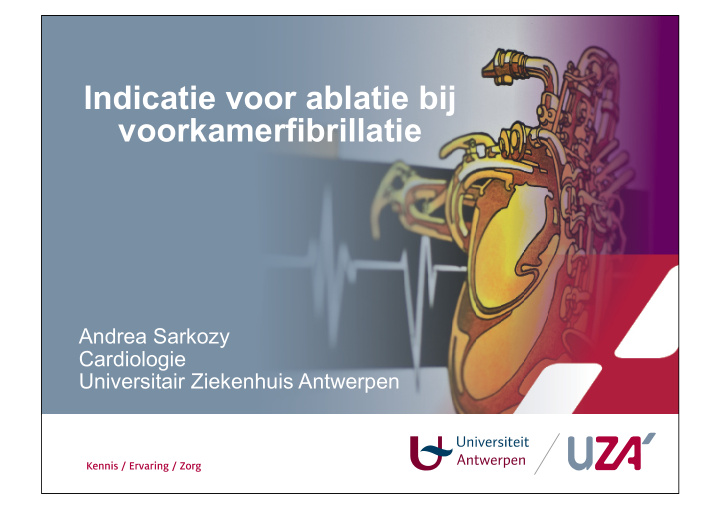



Indicatie voor ablatie bij voorkamerfibrillatie Andrea Sarkozy Cardiologie Universitair Ziekenhuis Antwerpen
Definition and Classification of AF - Practical aspects | Classification of AF | Paroxysmal, persistent, long-standing persistent, permanent | Electrical CV ≤ 48 hours or < 7 days = paroxysmal AF Calkins H: Europace. 2012;14:528, January C: JACC 2104
Klinische presentatie van VKF Nattel S: Eur Heart J 2014;35:1448–1456
Natural history of AF - progression | Yearly progression from paroxysmal/persistent to permanent AF: 3.7%-15% | Age, persistent AF, LA size | Heart failure, Age, TIA/Stroke, COPD , HTN, (HATCH) 2 | sleep apnea, obesitas De Sisti PACE 2013;37:345, 2 De Vos JACC 2010;55:725-31
Vroegtijdig interventie concept • AF geinduceerde elektrische en strukturele remodelling • Onderliggende CV ziekte veroorzaakt substraat remodelling • Veroudering geassocieerde substraat Nattel S: Eur Heart J 2014;35:1448–1456
Pulmonary vein isolation with catheter ablation
Interventional EP laboratory
Atrial Fibrillation: Catheter ablation of PV focus
TEE and fluoroscopy guided transseptal puncture
3D electroanatomical mapping | Placement of a circular mapping catheter (LASSO) and irrigated tip ablation catheter in the LA
Circumferentiel Pulmonary vein siolation with RF ablation
Indications for catheter ablation in AF • Good indications • Alternative drug therapy: failed / contraindicated / side effects • Benefit: High and long term decrease in AF recurrence - efficacy • Risk: as few as possible complications
Efficacy
Meta analysis of ablation efficacy | Paroxysmal AF | 1 y single procedure success: 69 % | 5 y single procedure success: 62%, multiple procedure: 79% | Persistent AF | 1 y single procedure success: 52 % | 3 y single procedure success: 42%, multiple procedures:77% Ganesan JAMA 2013;2:4549
Efficacy of persistent, long-standing persistent atrial fibrillation ablation Star AF study | Multicenter randomized trial of 589 pts in 12 countries with persistent AF | Single procedure success at 18 months off AAD for PVI alone: 48% | Two procedures + AAD for PVI alone: 72% Verma New Eng J Med 2015
Efficacy as compared to antiarrhythmic drugs Khan Circulation AEP 2014;7:853
Earlier ablation is associated with improved outcome | 4535 paroxysmal-persistent AF pts w ablation 1m to > 5y after first diagnosis | 1 year AF recurrence, death, HF hospitalization highest in most delayed group Bunch TJ et al: Heart Rhythm 2013;10:1257
Early ablation in patients without structural heart diseases might slow AF progression | 899 pts w median follow up 64 months, AF progression: 6.4% | Progression persistent:10%, long-standing persistent:14,6%, paroxysmal: 2,7% | Progression w comorbidities/cardiomyopathies: 29.9% vs “lone” AF: 9.1% Scaglione Heart Rhythm 2104
Very long-term efficacy of catheter ablation | 445 pts – free of AF 1 y postablation followed for additional 66 months | At 5 years 16,3% and 10 years 29,8% recurrence | Persistent AF and hypertension are independent risk factors Steinberg JS Heart Rhythm 2104
Decreased Stroke rate following ablation | AF ablation patients have a significantly lower risk of stroke compared to AF patients who do not undergo ablation independent of baseline stroke risk score and age | However, currently following AF ablation anticoagulation is based on CHADS-VASC score irrespective of the result of the ablation Bunch J Heart Rhythm 2013;10:1272
Efficacy of atrial fibrillation ablation in paroxysmal AF Smart AF Trial using CF sensing catheter | Prospective, multicenter, nonrandomized trial of 171 pts with PAF at 21 sites | Single-procedure 12 m success off AAD therapy: 72%, with CF in operator targeted range: 81% Natale JACC 2014;64:647-56
Safety
AF ablation USA database: 93801 ablation 2000-2010 Deshmukh Circulation 2013;128:2104
Safety of catheter ablation therapy as compared to drugs Calkins Circulation Arrhythmia 2009;2:349
Update on Indications of catheter ablation
2012 ESC AF Guideline update, 2012 HRS/EHRA/ECAS Expert Consensus Statement on AF Ablation, 2014 AHA/ACC/HRS AF guideline Camm AJ Eur Heart J. 2012;33:2719
Practical aspects | Personalized informed consent over efficacy and complications of the ablation procedure
Conclusions | Paroxysmal, Persistent, and Permanent AF classification should be used | Progression rate from paroxysmal to permanent AF is yearly 5% | Age, persistent AF, HTN, left atrial dilatation and structural heart and pulmonary disease are predictors | Early interventions might slow progression | Delay in AF ablation is associated with worse outcome
Conclusions | Catheter ablation is recommended (class I) in symptomatic paroxysmal AF following failure of one AAD (before amiodarone) | As first line therapy (class IIa) - in case AAD drugs are contraindicated | Personalized informed consent: | Single procedural 12 months success: 70% - 80%, 5y multiple procedures 80% - 85% | Major complications: 4-5% | RF ablation can be considered (class II/a) in symptomatic persistent AF following failure of one AAD | Older pts with dilated LA + structural HD have high recurrence/ progression rates – AAD postablation is frequently needed | Personalized informed consent: | Single procedural 12 months success: 50-60%, 5y Multiple procedures:70-75%
Recommend
More recommend